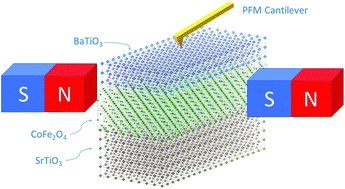Effect of substrate orientation on local magnetoelectric coupling in bi-layered multiferroic thin films†
Abstract
In this study we explore the prospect of strain-mediated magnetoelectric coupling in CoFe2O4–BaTiO3 bi-layers as a function of different interfacial boundary conditions. Pulsed laser deposition fabricated thin films on Nb:SrTiO3(100) and Nb:SrTiO3(111) single crystal substrates were characterized in terms of their peculiarities related to the structure–property relationship. Despite the homogeneous phase formation in both films, transmission electron microscopy showed that the bi-layers on Nb:SrTiO3(100) exhibit a higher number of crystallographic defects when compared to the films on Nb:SrTiO3(111). This signifies an intrinsic relationship of the defects and the substrate orientation. To analyze the consequences of these defects on the overall magnetoelectric coupling of the bi-layered films, piezoresponse force microscopy was performed in situ with an applied magnetic field. The local magnetic field dependence of the piezoresponse was obtained using principal component analysis. A detailed analysis of this dependence led to a conclusion that the bi-layers on Nb:SrTiO3(111) exhibit better strain-transfer characteristics between the magnetic and the piezoelectric layer than those which were deposited on Nb:SrTiO3(100). These strain transfer characteristics correlate well with the interface quality and the defect concentration. This study suggests that in terms of overall magnetoelectric coupling, the Nb:SrTiO3(111) grown bi-layers are expected to outperform their Nb:SrTiO3(100) grown counterparts.



 Please wait while we load your content...
Please wait while we load your content...